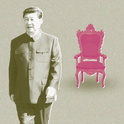Two individuals with the name Philippe Legrain appear to have written in response to my enthusiastic review of Ha-Joon Chang's defence of economic nationalism, Kicking Away the Ladder ("Free Trade Fallacy II," Prospect, February).
Legrain I agrees with Chang and me that both free trade and protection may be appropriate for different countries in different circumstances. According to Legrain I, "For sure, there is a respectable theoretical case for limited, and temporary, government support to infant industries..." Furthermore, Legrain I writes, "Lind concludes by calling for developing countries to have a choice in selecting a development strategy. Quite right-and they do."
Unlike Legrain I, a pragmatist, Legrain II is a free-market purist. While the first Legrain admits the feasibility of infant-industry protection, the second Legrain argues that there are no successful cases of infant-industry protection. He attributes the late 19th-century industrialisation of the US not to high-tariff import substitution policies, but to other factors, including "the rapid pace of technological innovation," "free capital flows" and the migration of "around 35m Europeans" to the US.
If immigration was a factor, then why did Germany and Japan-countries of net emigration-industrialise, after copying US import-substitution strategies, while Argentina, which received millions of European immigrants, did not? Rapid technological innovation alone cannot explain why one country industrialised and another did not. It is true, as Legrain II writes, that "British savings financed the development of the new world"-but that was the whole point of US import substitution. While British manufactures were kept out by high tariffs, British investors were welcome to invest in US factories-and to repatriate their profits. The same cause-protection-produced the same effect-local industrialisation-when British dominions like Canada and Australia won the right to protect their markets.
Legrain II argues that the power of vested interests will ensure that infant-industry protection becomes permanent. He fails to explain how historically protectionist countries like Britain, the US and Germany later adopted liberal approaches to trade, against the resistance of domestic industries with a stake in protection.
Legrain II writes that while "developing countries with open economies are catching up with rich ones, those with closed economies are falling further behind." This is true only if you treat the mercantilist export-oriented states of east Asia, which protect their own markets while targeting the US consumer market, as "open economies." Legrain II cites "Bangalore in India, the countryside around Ho Chi Minh City in Vietnam, China's coastal regions or Ciudad Ju?z on Mexico's border with the US" as examples of "open economies." These are, in fact, export-processing zones embedded in much larger, heavily statist economies. (Ju?z and other Mexican sweatshop zones are suffering, now that US multinationals are moving production from Mexico to China, where workers have even lower wages and fewer rights.)
Moreover, Legrain II redefines the free market to include government policy. "Where the South Korean government provided cheap loans to companies, it ensured that the money was invested productively by cutting off funds to companies that were not successful exporters. Indirectly, the market... picked winners." The magic word "indirectly" transforms South Korean industrial policy into a free-market triumph. Medieval schoolmen would have been impressed by this rhetorical feat. Classical liberalism, like Marxism, is a secular Enlightenment religion masquerading as an economic doctrine. Legrain I is an agnostic, Legrain II is a true believer.











